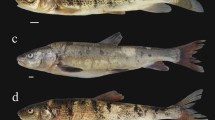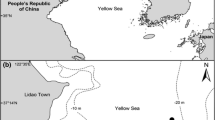Abstract
Trophic relationships of four sympatric fish species of the family Opisthocentridae (Perciformes), that is, Opisthocentrus ocellatus, O. tenuis, O. zonope, and Pholidapus dybowskii, were studied by analyzing their stomach contents and signatures of stable nitrogen and carbon isotopes (δ15N and δ13C) in soft tissues. The mean carbon isotope signature values ranged from –20.04 ± 0.95 to –15.44 ± 0.98, which indicated a wide range of primary carbon sources. The highest nitrogen isotope signature values (10.71 ± 0.55) and the maximum isotope niche width were recorded for Ph. dybowskii. Amphipods are the major food item of all the fish species under study, which was confirmed by a significant overlap of their isotope niches. The partitioning of trophic niches is explained by the selective consumption of prey crustaceans that are specific to each of the fish species and also by the use of aquatic invertebrates from different taxonomic groups as an additional food supply. The Schoener’s similarity index, calculated on the basis of relative abundances of food items identified to species, showed no competitive relationships between all of the fish species under study. The values of the index between the most phylogenetically close species O. ocellatus and O. tenuis were at a minimum.


Similar content being viewed by others

REFERENCES
Balanov, A.A., Epur, I.V., Zemnukhov, V.V., and Markevich, A.I., Species composition and seasonal dynamics of species richness of fish community in the Srednyaya Bight (Peter the Great Bay, Japan Sea), Izv. Tikhookean. Nauchno-Issled. Inst. Rybn. Khoz. Okeanogr., 2010, vol. 163, pp. 158–171.
Galeev, A.I., Balanov, A.A., Markevich, A.I., and Nekrasov, D.A., Using brown alga Desmarestia viridis (Desmarestiaceae) by juvenile fish Opisthocentrus spp. (Stichaeidae) as shelter, J. Ichthyol., 2015, vol. 55, no. 1, pp. 134–137.
Gorbatenko, K.M., Kiyashko, S.I., Lazhentsev, A.E., et al., Bentho-pelagic relations in the deep-water part of the Okhotsk Sea by the data of stable isotopes C and N analysis, Izv. Tikhookean. Nauchno-Issled. Inst. Rybn. Khoz. Okeanogr., 2015, vol. 183, no. 4, pp. 200–216.
Kiyashko, S.I., Velivetskaya, T.A., and Ignatiev, A.V., Sulfur, carbon, and nitrogen stable isotope ratios in soft tissues and trophic relationships of fish from the near-shore waters of the Peter the Great Bay in the Sea of Japan, Russ. J. Mar. Biol., 2011, vol. 37, no. 4, 297.
Lebedev, N.V., Experience in assessment of fish predation on mollusks and estimation of fish abundance in a commercial aggregation at feeding grounds, Vopr. Ikhtiol., 1960, vol. 16, pp. 34–55.
Markevich, A.I., Structure of groups, ecology, and behavior of rockfish of the genus Sebastes of the Far Eastern Marine Reserve (Peter the Great Bay, Sea of Japan), Extended Abstract of Cand. Sci. (Biol.) Dissertation, Vladivostok: Dal’nauka, 1998.
Markevich, A.I., Fish community characteristics of a small bay of Bol’shoy Pelis Island (Far Eastern Marine Biosphere Reserve), Biota Sreda Zapov. Dal’nego Vostoka, 2014, vol. 2, pp. 144–166.
Markevich, A.I., Fish monitoring of the Far Eastern Marine Reserve, Biota Sreda Zapov. Dal’nego Vostoka, 2015, no. 5, pp. 46–55.
Markevich, A.I., Checklist of fish and fish-like vertebrates of Far Eastern Marine Reserve, Biota Sreda Zapov. Dal’nego Vostoka, 2015, no. 1, pp. 109–137.
Markevich, A.I., Monitoring of fish in the coastal biotopes of the southern part of Far Eastern Marine Reserve (Peter the Great Bay, Japan Sea), Izv. Tikhookean. Nauchno-Issled. Inst. Rybn. Khoz. Okeanogr., 2018, vol. 192, pp. 37–46.
Markevich, A.I., Subote, A.E., Zimin, P.S., and Fishchenko, V.K., The first experience of long-time underwater video observation system using for biological monitoring in the Peter the Great Bay (the Sea of Japan), Vestn. Dal’nevost. Otd. Ross. Akad. Nauk, 2015, vol. 1, no. 179, pp. 86–92.
Metodicheskoye posobiye po izucheniyu pitaniya i pishchevykh otnoshenii ryb v estestvennykh usloviyakh (A Methodical Guide to the Study of Diet and Feeding Relationships of Fish in Natural Conditions), Moscow: Nauka, 1974.
Pianka, E.R., Evolutionary Ecology, New York: Harper and Row, 1978.
Popova, O.A. and Reshetnikov, Yu.S., On complex indices in investigation of fish feeding, J. Ichthyol., 2011, vol. 51, no. 8, 686.
Sokolovskii, A.S., Sokolovskaya, T.G., and Yakovlev, Yu.M., Ryby zaliva Petra Velikogo (Fishes of Peter the Great Bay), Vladivostok: Dal’nauka, 2009.
Sokolovskiy, A.S., Sokolovskaya, T.G., Kharin, V.E., and Dolganov, S.M., Ichthyofauna of Vostok Bay Sea of Japan, Biota Sreda Zapov. Dal’nego Vostoka, 2014, no. 1, pp. 71–99.
Chislenko, L.L., Nomogrammy dlya opredeleniya vesa vodnykh organizmov po razmeram i forme tela: morskoi mezobentos i plankton (Nomograms to Determine Weight of Aquatic Organisms on the Basis of Body Size and Shape: Marine Mesobenthos and Plankton), Leningrad: Nauka, 1968.
Shorygin, A.A., Pitaniye i pishchevye vzaimootnosheniya ryb Kaspiiskogo morya (Diet and Feeding Relationships of Fish in the Caspian Sea), Moscow: Pishchepromizdat, 1952, vol. 1.
Beals, E.W., Bray-Curtis ordination: An effective strategy for analysis of multivariate ecological data, Adv. Ecol. Res., 1984, vol. 14, pp. 1–55.
Berg, J., Discussion of methods of investigating the food of fishes, with reference to a preliminary study of the prey of Gobiusculus flavescens (Gobiidae), Mar. Biol., 1979, vol. 50, no. 3, pp. 263–273.
Choi, B., Kim, W.-S., Ji, C.W., et al., Application of combined analyses of stable isotopes and stomach contents for understanding ontogenetic niche shifts in silver croaker (Pennahia argentata), Int. J. Environ. Res. Public Health, 2021, vol. 18, no. 8, 4073. https://doi.org/10.3390/ijerph18084073
Clarke, K.R., Non-parametric multivariate analyses of changes in community structure, Aust. J. Ecol., 1993, vol. 18, no. 1, pp. 117–143.
Colloca, F., Carpentieri, P., Balestri, E., and Ardizzone, G., Food resource partitioning in a Mediterranean demersal fish assemblage: The effect of body size and niche width, Mar. Biol., 2010, vol. 157, no. 3, pp. 565–574.
Davis, A.M., Blanchette, M.L., Pusey, B.J., et al., Gut content and stable isotope analyses provide complementary understanding of ontogenetic dietary shifts and trophic relationships among fishes in a tropical river, Freshwater Biol., 2012, vol. 57, no. 10, pp. 2156–2172.
Dineen, G., Harrison, S.S.C., and Giller, P.S., Diet partitioning in sympatric Atlantic salmon and brown trout in streams with contrasting riparian vegetation, J. Fish Biol., 2007, vol. 71, no. 1, pp. 17–38.
Fedosov, A.E., Tiunov, A.V., Kiyashko, S.I., and Kantor, Yu.I., Trophic diversification in the evolution of predatory marine gastropods of the family Terebridae as inferred from stable isotope data, Mar. Ecol.: Prog. Ser., 2014, vol. 497, pp. 143–156.
German, D.P., Gawlicka, A.K., and Horn, M.H., Evolution of ontogenetic dietary shifts and associated gut features in prickleback fishes (Teleostei: Stichaeidae), Comp. Biochem. Physiol., Part B: Biochem. Mol. Biol., 2014, vol. 168, pp. 12–18.
German, D.P., Sung, A., Jhaveri, P., and Agnihotri, R., More than one way to be an herbivore: Convergent evolution of herbivory using different digestive strategies in prickleback fishes (Stichaeidae), Zoology, 2015, vol. 118, no. 3, pp. 161–170.
Hertz, E., Trudel, M., El-Sabaawi, R., et al., Hitting the moving target: Modelling ontogenetic shifts with stable isotopes reveals the importance of isotopic turnover, J. Anim. Ecol., 2016, vol. 85, no. 3, pp. 681–691.
Fox, R.J. and Bellwood, D.R., Unconstrained by the clock? Plasticity of diel activity rhythm in a tropical reef fish, Siganus lineatus, Funct. Ecol., 2011, vol. 25, no. 5, pp. 1096–1105.
Jackson, A.L., Inger, R., Parnell, A.C., and Bearhop, S., Comparing isotopic niche widths among and within communities: SIBER - Stable Isotope Bayesian Ellipses in R., J. Anim. Ecol., 2011, vol. 80, no. 3, pp. 595–602.
Kronfeld-Schor, N. and Dayan, T., Partitioning of time as an ecological resource, Annu. Rev. Ecol., Evol. Syst., 2003, vol. 34, no. 1, pp. 153–181.
Kruskal, J.B. and Wish, M., Multidimensional Scaling, Sage University Papers Series: Quantitative Application in the Social Sciences, no. 07-011, Newbury Park, CA: Sage, 1978.
Kwak, S.N., Baeck, G.W., and Klumpp, D.W., Comparative feeding ecology of two sympatric greenling species, Hexagrammos otakii and Hexagrammos agrammus in eelgrass Zostera marina beds, Environ. Biol. Fishes, 2005, vol. 74, no. 2, pp. 129–140.
Layman, C.A., Arrington, D.A., Montaña, C.G., and Post, D.M., Can stable isotope ratios provide for community-wide measures of trophic structure?, Ecology, 2007, vol. 88, no. 1, pp. 42–48.
Murillo-Cisneros, D.A., O’Hara, T.M., Elorriaga-Verplancken, F.R., et al., Trophic assessment and isotopic niche of three sympatric ray species of western Baja California Sur, Mexico, Environ. Biol. Fishes, 2019, vol. 102, no. 12, pp. 1519–1531.
Ochiai, T. and Fuji, A., Energy transformations by a blenny (Opisthocentrus ocellatus) population of Usu Bay, southern Hokkaido, Bull. Fac. Fish., Hokkaido Univ., 1980, vol. 31, no. 4, pp. 314–326.
Pacioglu, O., Zubrod, J.P., Schulz, R., et al., Two is better than one: Combining gut content and stable isotope analyses to infer trophic interactions between native and invasive species, Hydrobiologia, 2019, vol. 839, no. 1, pp. 25–35.
Peterson, B.J. and Fry, B., Stable isotopes in ecosystem studies, Annu. Rev. Ecol. Syst., 1987, vol. 18, no. 1, pp. 293–320.
Post, D.M., Using stable isotopes to estimate trophic position: Models, methods, and assumptions, Ecology, 2002, vol. 83, no. 3, pp. 703–718.
R Core Team, R: A Language and Environment for Statistical Computing, R Foundation for Statistical Computing, Vienna, Austria. https://www.R-project.org/. Accessed April 30, 2020.
Rudolf, V.H.W., A multivariate approach reveals diversity of ontogenetic niche shifts across taxonomic and functional groups, Freshwater Biol., 2020, vol. 65, no. 4, pp. 745–756.
Sánchez-Hernández, J. and Cobo, F., Summer food resource partitioning between four sympatric fish species in Central Spain (River Tormes), J. Vertebr. Biol., 2011, vol. 60, no. 3, pp. 189–202.
Sánchez-Hernández, J., Servia, M.J., Vieira-Lanero, R., and Cobo, F., Prey trait analysis shows differences in summer feeding habitat use between wild YOY Atlantic salmon and brown trout, Ital. J. Zool., 2013, vol. 80, no. 3, pp. 449–454.
Schoener, T.W., Nonsynchronous spatial overlap of lizards in patchy habitats, Ecology, 1970, vol. 51, no. 3, pp. 408–418.
Shiogaki, M., A review of the genera Pholidapus and Opisthocentrus (Stichaeidae), Jpn. J. Ichthyol., 1984, vol. 31, pp. 213–224.
StatSoft, Inc. STATISTICA (data analysis software system), version 10. https://www.statsoft.com. Accessed April 30, 2020.
Varela, J.L., Sorell, J.M., Laiz-Carrion, R., et al., Stomach content and stable isotope analyses reveal resource partitioning between juvenile bluefin tuna and Atlantic bonito in Alboran (SW Mediterranean), Fish. Res., 2019, vol. 215, pp. 97–105.
ACKNOWLEDGMENTS
We are cordially grateful to E.N. Selivanova, O.A. Khlistun, M.A. Zenina, A.V. Chernyshev, T.V. Chernova, and O.A. Golovan’ for their help in identification of components of fish stomach contents. We also thank the anonymous reviewers for their useful comments made during our work on the manuscript. We gratefully commemorate Dr. V.A. Kudryashov who provided us with irreplaceable help in the past.
Funding
The study was supported by the Ministry of Science and Higher Education of the Russian Federation, project no. FZNS-2021-0011.
Author information
Authors and Affiliations
Corresponding author
Ethics declarations
Conflict of interest. The authors declare that they have no conflicts of interest.
Statement on the welfare of animals. All applicable international, national, and/or institutional guidelines for the care and use of animals were followed.
Additional information
Translated by E. Shvetsov
Rights and permissions
About this article
Cite this article
Rutenko, O.A., Ivankov, V.N., Kiyashko, S.I. et al. The Trophic Relationships of Sympatric Fish Species of the Genera Opisthocentrus and Pholidapus (Perciformes: Opisthocentridae) in the Sea of Japan. Russ J Mar Biol 48, 149–157 (2022). https://doi.org/10.1134/S1063074022030075
Received:
Revised:
Accepted:
Published:
Issue Date:
DOI: https://doi.org/10.1134/S1063074022030075



